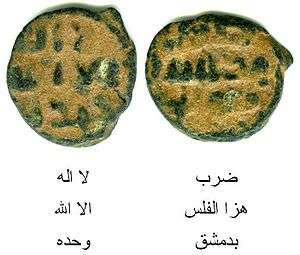Fals
This article is about the coin. For the town in France, see Fals, Lot-et-Garonne. For the Indonesian singer-songwriter, see Iwan Fals.

A fals minted in Damascus between 696 and 750.
The fals (plural fulus) was a copper coin produced by the Umayyad caliphate (661-750) and the Abbasid caliphate (750-1258) beginning in the late 7th century. The name is a corruption of follis, a Roman and later Byzantine copper coin. The fals usually featured ornate Arabic script on both sides. Various copper fals were produced until the 19th century.
The word fulus is still used in modern spoken Arabic for money.
See also
This article is issued from Wikipedia - version of the 9/17/2016. The text is available under the Creative Commons Attribution/Share Alike but additional terms may apply for the media files.